ASM Metals HandBook Vol. 8 - Mechanical Testing and Evaluation
Подождите немного. Документ загружается.

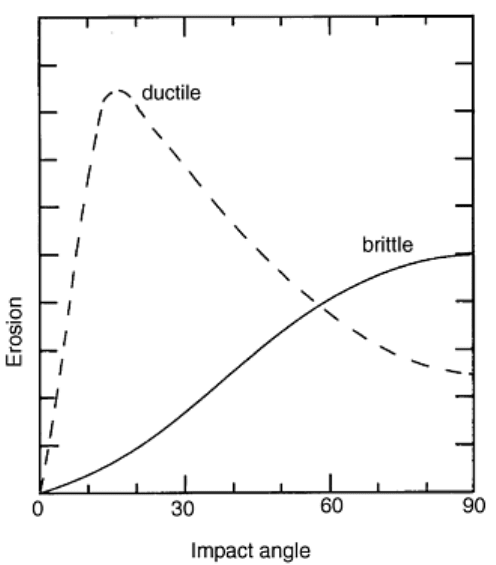
Fig. 2 Typical dependence of erosion (defined as mass lost per unit mass of impinging particles) on
impact angle (defined as the angle between the impact direction and the surface)
Materials that erode by the formation and intersection of brittle fractures, such as inorganic glasses impacted by
hard angular particles that are large enough to cause local cracking, show peak erosion for normal incidence
and a steady reduction in erosion as the impact angle falls. Figure 2 also shows this behavior. The two types of
behavior are often referred to as ductile and brittle, respectively. However, it is not safe to deduce the
mechanisms of material removal on the basis of the angular dependence of erosion, since in some systems
ductile processes can lead to peak erosion at 90°, and transitions in fracture behavior can result in atypical
angular dependence of erosion even in a “classically brittle” material. Intermediate behavior, with peak erosion
at 45 to 60°, is not unknown.
The particles used in an erosion test must be well characterized. The size of the particles can influence the
erosion rate in two important and distinct ways. Particles of different sizes, striking the surface at the same
angle and velocity, will generally remove different amounts of material per unit mass of particles, although for
particles larger than about 100 μm striking a ductile metal this variation may be small. This dependence of
erosion on particle size represents a genuine size effect. In some erosion test methods, as discussed later, the
impact velocity will itself vary with particle size, and since erosion is generally a strong function of velocity,
this effect contributes to a further dependence of the measured erosion rate on particle size. For these reasons, it
is clear that, wherever possible, the size range of the particles used in an erosion test should be known and
should be as narrow as possible. Particles are often classified by sieving, and standard sources that discuss the
principles and optimal procedures for this method are available (Ref 3, 4). Specification of the sieve sizes may
be sufficient to define the range of particle size used in a test; however, laser granulometry is a readily available
technique that can be used to provide a more accurate description of the particle size distribution.
The erodent particle material is an important factor, as illustrated in Fig. 3, that shows results for the erosion of
a glass-bonded alumina (a common erosion-resistant ceramic), tested with silicon carbide, alumina, and silica
particles, all of the same size (125–150 μm). The erosion caused by the silicon carbide particles was more than
ten times that caused by the same mass of silica particles. A major factor responsible for this effect is the
relative hardness of the erodent particles and the surface being eroded. In this example, both the silicon carbide
and the alumina particles, which were commercial abrasives, were significantly harder than the alumina
specimen. The silica, in contrast, had about the same hardness as the specimen:
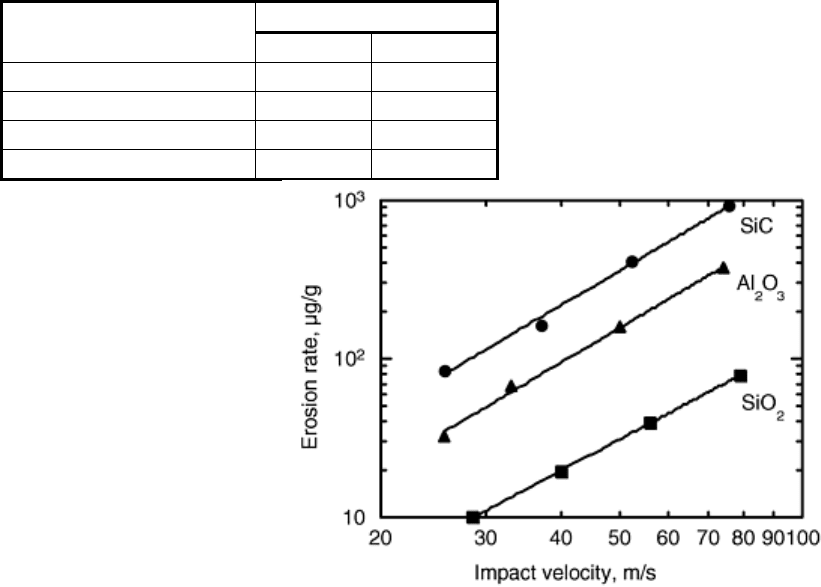
Vickers microhardness
Specimen or erodent
GPa
10
6
psi
Alumina specimen 12.7
1.84
Silicon carbide particles
33.4
4.84
Alumina particles 26.5
3.84
Silica particles 13.1 1.90
Fig. 3 Influence of particle material on erosion rate, for erosion of a sintered glass-bonded alumina
ceramic by silica, alumina, and silicon carbide particles, 125–150 μm in diameter, at normal incidence.
Adapted from Ref 5
Shape also plays a role in determining the relative erosivity of different particles (Ref 6) and is difficult to
separate from other particle properties, since particle shape is often determined by the fracture processes by
which the particles themselves are formed. As in the case of particle size, there is an intrinsic effect of shape on
the erosion rate, which can lead to angular particles producing up to ten or more times the erosion caused by
spherical particles of the same material. Measurement of particle shape is not straightforward because, although
there are many possible methods of assessing shape, it is unclear which method is most appropriate in the
context of erosive wear testing. Qualitative descriptors such as “rounded,” “subangular,” “angular,” and so on,
are often used and may be adequate in conjunction with a more detailed specification of the material and source
of the erodent particles.
For these reasons, it is important that if the purpose of erosion testing is to compare material behavior or obtain
quantitative measurements of erosion rate in the context of a particular engineering application, appropriate
erodent particles are used in the test. Not only should the particle size and shape be representative of the
application in question, but the particle material should also provide a realistic simulation of the properties of
the actual particles. Although the ready availability of reproducible commercial abrasive particles such as
silicon carbide or alumina with well-defined size may suggest their use in erosion testing, it is important to
appreciate that they are much harder than most naturally occurring erosive particles, which are often silica or
silicate minerals. Not only may the absolute values of erosion rate measured with very hard particles be
misleading, but the mechanisms of damage and even the ranking of erosion rates of materials may be different.
Because damage is suffered by the erodent particles when they strike a surface, the properties of the particles
after they have been used in an erosion test will differ, often significantly, from those of fresh particles. Even if
gross fracture of the particles is avoided, subtle changes in shape can occur. If at all possible, erodent particles
should, therefore, not be reused for erosion testing.
References cited in this section
2. I.M. Hutchings, Tribology: Friction and Wear of Engineering Materials, CRC Press, Inc., 1992, p 171–
197

3. Manual on Testing Sieving Methods, ASTM Manual 32, ASTM, 1998
4. “Test Sieving,” BS 1796-1, British Standards Institution, London (also ISO 2591-1)
5. P.H. Shipway and I.M. Hutchings, The Role of Particle Properties in the Erosion of Brittle Materials,
Wear, Vol 193, 1996, p 105–113
6. S. Bahadur and R. Badruddin, Erodent Particle Characterization and the Effect of Particle Size and
Shape on Erosion, Wear of Materials 1989, K.C. Ludema, Ed., ASME, 1989, p 143–153
Solid Particle Erosive Wear Testing
Ian M. Hutchings, University of Cambridge (England)
Erosion Test Methods
Laboratory-scale erosion testing is performed for several reasons: to provide data on absolute or relative wear
rates under specific conditions, to examine the validity of theoretical models, or to study the mechanisms of
wear. The first of these objectives can include data on the relative behavior of different materials and provides
information of direct value to the design engineer, while the others are of more value in improving
understanding of erosive wear.
Methods used for laboratory erosion testing can be divided into those in which the particles are accelerated in a
gas stream and those where circular motion is used to achieve the impact velocity. Four methods are shown
schematically in Fig. 4 and are discussed in detail subsequently. Of these, the gas-blast test rig (Fig. 4a) and the
centrifugal accelerator (Fig. 4b) are the most widely used methods.
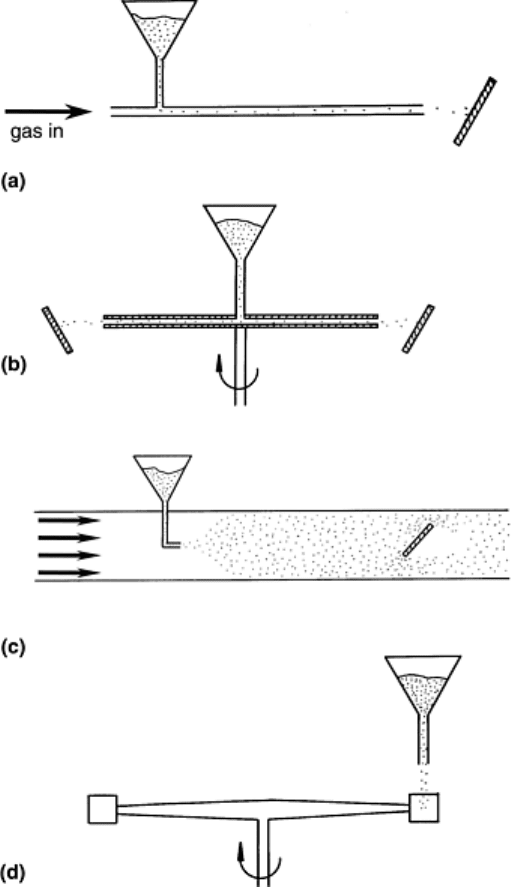
Fig. 4 Schematic diagrams showing four classes of erosion test methods. (a) Gas-blast rig. (b) Centrifugal
accelerator. (c) Wind tunnel. (d) Whirling arm tester
Gas-Blast Method. In the gas-blast or jet impingement test, particles are entrained into a gas stream and
accelerated along a nozzle. The particles leave the end of the nozzle and then strike the test specimen, which is
fixed at a known angle to the axis of the nozzle some distance from its end. The acceleration nozzle used in this
test method is generally a plain cylindrical tube for ease of construction and replacement. There are national
standards relating to this type of test method, but nonstandard designs are also commonly used.
In ASTM standard G 76 (Ref 7), the use of a nozzle 50 mm (2 in.) long with a bore of 1.50 mm (0.06 in.) is
recommended. A former German standard (DIN 50332) suggested the use of a nozzle 120 mm (4.7 in.) long
with an internal diameter of either 8 or 18 mm (0.3 or 0.7 in.), depending on the test conditions. Sheldon and
coworkers (Ref 8) used a nozzle 305 mm (12 in.) long with an internal diameter of 4.95 mm (0.19 in.), and
similar dimensions have been used in many other experimental programs. The aspect ratio (length:diameter) of
this nozzle is 61.6, approximately twice that of the ASTM standard nozzle. Other investigators have used
considerably longer nozzles. For example, Marshall and others (Ref 9) used a nozzle 3 m (9.8 ft) long with a
bore of 9.5 mm (0.37 in.) (aspect ratio = 316), while Andrews and others (Ref 10) used nozzles 4 m (13.1 ft)
long with 25 mm (1 in.) internal diameter (aspect ratio = 160), and 1 m (3.3 ft) long with an internal diameter of
10 mm (0.4 in.) (aspect ratio = 100). The ASTM standard suggests that a length:diameter ratio of at least 25 is
desirable to achieve an acceptable particle velocity distribution in the stream.
The velocity with which the particles leave the nozzle and strike the specimen will depend on the velocity of
the gas stream, on the drag forces acting on the particles, and on the distance over which the particles accelerate
along the nozzle. In long nozzles of large diameter, the particles may reach essentially the same speed as the
gas stream, but in short or narrow nozzles, the particle velocity may be significantly lower than that of the gas.
Accurate knowledge of the particle exit velocity is therefore essential unless the purpose of the test is simply to
compare material behavior under constant, but unspecified, erosion conditions.
A long nozzle might be considered to be beneficial on the grounds that it might lead to a higher particle exit
velocity for a given gas pressure. It might also be assumed that the divergence of the erodent particle stream on
leaving the nozzle would be less, leading to less uncertainty in the angle with which the particles strike the
target. A long nozzle might also have the advantage of reducing the spread in the velocities of particles where
there is a distribution of particle sizes in the erodent supply. However, the assumption that longer nozzles give
higher particle exit velocities is not necessarily correct. It is true that with a longer nozzle the particles reach a
higher proportion of the gas exit velocity than in shorter nozzles, but on the other hand, for the same overall
pressure drop, the gas velocity will be lower than with a shorter nozzle due to friction between the gas and the
nozzle wall. A second important influence on particle exit velocity arises from the collision of the particles
against the nozzle wall, which causes a retarding effect. The internal surface topography (i.e., roughness) of the
nozzle wall therefore affects the particle exit velocity.
Particles can be fed into the gas stream in various ways. One simple method is to use a pressurized particle
feeder in which particles are metered by the rotation of an electrically driven disk carrying a groove from which
the powder is supplied through a pressurized tube to a mixing chamber at the high-pressure end of the nozzle.
Powder feeders of this type are commercially available, for example, to supply plasma-spray guns. An
alternative method of erodent feeding uses a rotating grooved disk at atmospheric pressure from which the
powder is sucked through a feed tube into a constricted portion of the airstream in which a low pressure region
is created. Screw feeders can also be used. However the erodent particles are metered, good control over the
feed rate is desirable.
Figure 5 shows the layout of a typical laboratory-scale gas-blast erosion rig. Suction created in the ejector
causes the erodent particles to be drawn into a feed tube from a groove in a slowly rotating turntable, which is
fed by gravity from a hopper. The particles are then mixed into the main gas stream. By controlling the speed of
rotation of the turntable, a constant particle feed rate can be accurately maintained. The acceleration nozzle is a
stainless steel tube, typically 5 mm (0.2 in.) in internal diameter and 300 mm (11.8 in.) long. Since the nozzle
wears progressively in use, the diameter should be regularly monitored to ensure constant test conditions. The
test sample is clamped at an accurately known angle to the axis at a standoff distance of about 5 nozzle
diameters from the end of the nozzle. Arrangements are made to collect the erodent particles and debris from
the airstream before it is vented from the apparatus. Since the particle velocity is controlled by maintaining a
fixed pressure drop between the ends of the nozzle, it is relatively straightforward to achieve reproducible and
well-characterized conditions in such a rig.
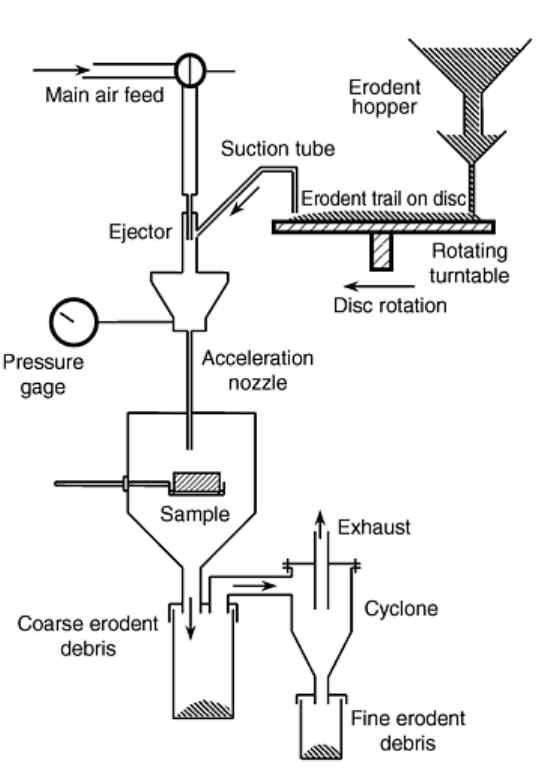
Fig. 5 Typical small-scale laboratory gas-blast erosion rig. Erodent particles are accelerated in a gas
stream along a cylindrical nozzle and strike a specimen fixed at the end of the nozzle. Source: Ref 11
A typical test procedure would involve mounting the specimen at the appropriate distance and angle from the
end of the nozzle, filling the particle feeder with a weighed quantity of sieved erodent particles, setting the
pressure at the nozzle entry to the level needed to achieve the desired particle velocity, starting the particle
feeder at an appropriate rate, checking and adjusting the nozzle pressure if necessary, and running the test until
all the particles have passed through the apparatus. The specimen is handled carefully, cleaned (to remove loose
particles), and weighed before and after the test. The specimen is then replaced in the apparatus in the same
position and orientation, and the test run is repeated to produce further erosion of the same region of the surface
until sufficient data have been gathered (see the section “Data Analysis and Interpretation” in this article).
The use of preweighed quantities of erodent in each test, and running the test until the particles have all passed
through the rig, is preferable to running the test for a set time at a preset feed rate because a constant feed rate
cannot always be assured.
Computational models are available to predict particle velocities in gas-blast erosion testing, but in order to
make accurate predictions they must take account not only of the size, density, and drag coefficient (which will
depend on the shape) of the particles, but also of the nozzle wall friction and the effects of particle-wall and
even particle-particle interactions. The plume of particles leaving the end of a cylindrical nozzle contains some
particles that diverge quite markedly from the nozzle axis, showing that impacts between particles and the
nozzle wall can be significant (Ref 11). Theoretical models for particle velocity are therefore no substitute for
accurate measurements under realistic operating conditions performed by one of the methods discussed in the
section “Measurement of Particle Velocity” in this article.
For some purposes, however, a simple empirical model has been found to be useful. The following equation
provides a good fit to the dependence of particle velocity on air pressure for a cylindrical nozzle 4.9 mm (0.19
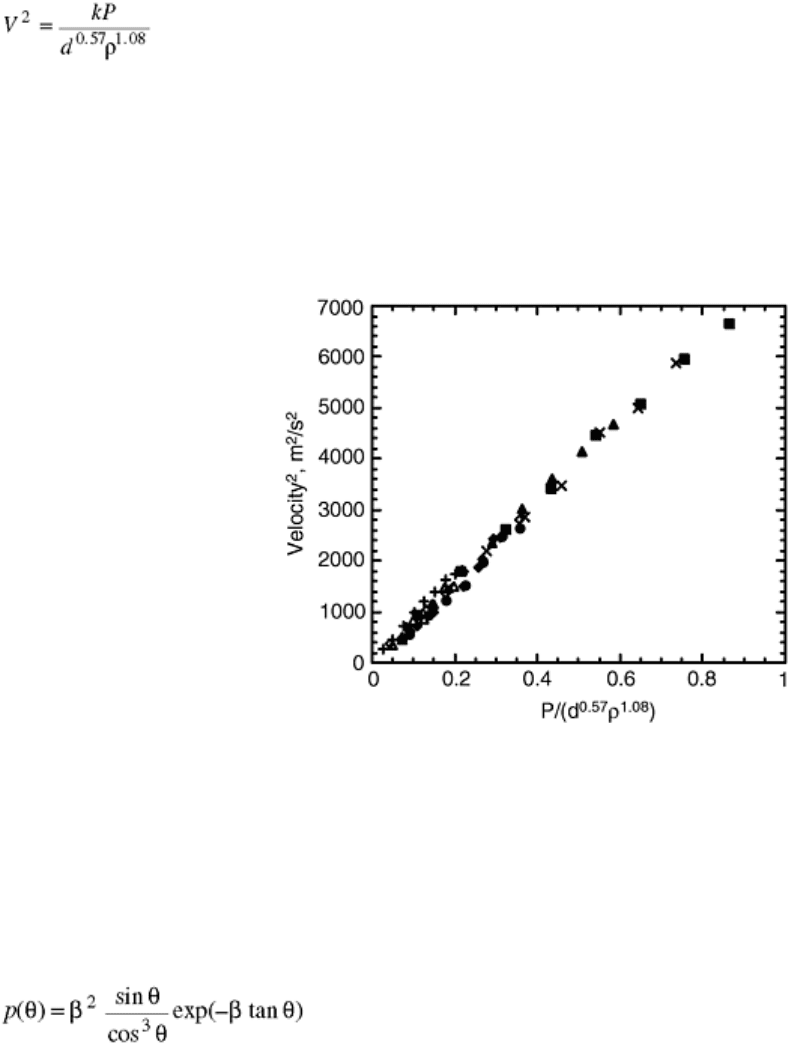
in.) in diameter and 308 mm (12.1 in.) long, with one end at atmospheric pressure, along which particles are
accelerated in an airstream (Ref 12):
(Eq 2)
where V is the exit velocity of the particles (in m/s), P is the gage pressure at the high-pressure end of the
nozzle (in kPa; 100 kPa = 1 bar), d is the diameter of the particles (in micrometers), and ρ is the density of the
particles (in Mg/m
3
). For these conditions and with the data expressed in the units given, k = 7900. As shown in
Fig. 6, this equation provides a good fit to measured particle velocities up to about 80 m/s. A linear variation of
(particle velocity)
2
with gas pressure has also been demonstrated for cylindrical nozzles with other aspect ratios,
and the functional dependence of velocity on particle size and density has been shown to be similar to that of
Eq 2. It is likely that an empirical relationship similar to Eq 2 can be used, after suitable calibration, for many
designs of gas-blast erosion rig.
Fig. 6 Empirical correlation between particle velocity and nozzle pressure drop, P; mean particle
diameter, d; and particle material density, ρ, for erodent particles of a wide range of sizes and materials
in an air-blast erosion rig with a nozzle 308 mm (12 in.) long and 4.90 mm (0.19 in.) internal diameter.
The data are well fitted by Eq 2. Adapted from Ref 12
The stream of particles leaving the nozzle diverges significantly because of particle-wall collisions and particle-
particle interactions. This divergence can be described by a simple function (Ref 11). The proportion of
particles traveling at angles between θ and θ + dθ to the nozzle axis, p(θ)dθ, is given by:
(Eq 3)
where β is a dimensionless quantity that describes the spreading of the plume and has been termed the focus
coefficient. The value of β depends on the shape of the erodent particles and on the internal roughness of the
nozzle wall, as well as on the impact velocity; typical values lie in the range of approximately 10 to 25, with a
low value of β corresponding to a highly divergent stream. Because of this divergence, the area of the specimen
exposed to the erodent stream must be significantly greater than the cross-sectional area of the end of the nozzle
in order to ensure that most of the particles strike the specimen. For a typical nozzle diameter of 5 mm (0.2 in.)
and a specimen mounted at a distance of 20 mm (0.8 in.) from the end of the nozzle, a specimen width of at
least 25 mm (1 in.) is necessary to avoid significant error from this source.
Centrifugal Accelerator. In the centrifugal accelerator, illustrated by the apparatus shown in Fig. 7, the erodent
particles are fed to the center of a rotating disk, usually with a screw or vibratory feeder, and then travel
outwardly along radial slots or tubes in the disk. They leave the disk at the periphery with a tangential
component of velocity equal to that of the disk itself and a radial velocity component that depends on their
motion within the radial channels. Specimens are mounted at points surrounding the periphery of the disk and
are exposed to a series of streams of erodent particles as the radial tubes sweep past. The use of a centrifugal
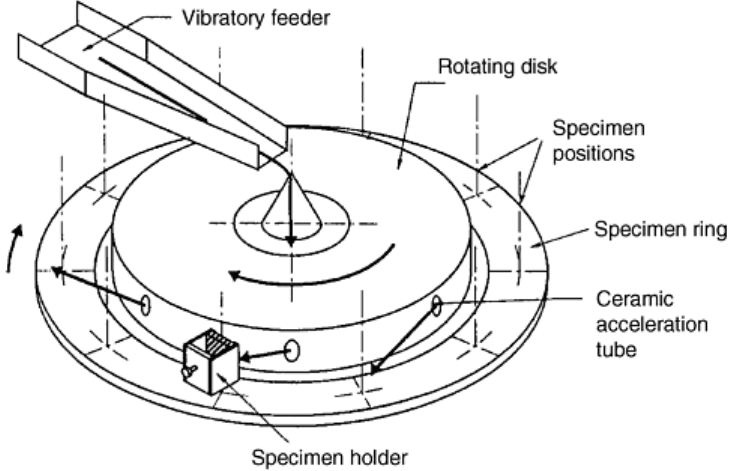
accelerator for erosion testing was specified in a national standard of the former Soviet Union (GOST
23.201.78), and examples of such apparatus have been described in Ref 13, 14, and 15.
Fig. 7 Typical centrifugal accelerator test rig. Erodent particles are fed into the center of a rotating disk
and emerge through radial tubes to strike the specimens, which are arranged in a ring around the
periphery of the disk. Source: Ref 13
The method has the advantage over the gas-blast method in that a large number of specimens can be subjected
to the same erosion conditions simultaneously, and it is therefore well suited to performing screening tests on
many different materials. The specimens are often mounted on a ring that rotates slowly around the rotating
disk, to eliminate any possible bias associated with specific specimen locations. Maximum numbers of
specimens per test have ranged up to 30 in different designs of rig, with rotating disk diameters between 200
and 600 mm (8 and 24 in.). The apparatus shown in Fig. 7 (Ref 13) has a disk 240 mm (9.4 in.) in diameter,
containing six radial tubes, each with an internal bore diameter of 2.6 mm (0.10 in.). The particles are supplied
to the center of the disk by a vibratory feeder at a constant rate, and care is taken in the design to ensure that the
particle flow is split evenly between the six tubes. Typically, ten samples are placed symmetrically around the
carrier ring; each specimen holder can be angled independently to achieve impact angles in the range of 5 to
90°. The specimens are all mounted in the vertical plane.
Constant particle impact velocity is achieved through control of the disk speed, which is readily measured.
However, the velocity of the particles results from both radial and tangential motion; typical particle trajectories
are illustrated in Fig. 8. Accurate determination of the impact velocity, and of the impact angle at the specimen
surface, thus requires a knowledge of the ratio of the velocity components or the angle of motion relative to the
radial direction. Probably the simplest method of determining these is to measure the direction of motion of the
particles experimentally, by allowing them to pass through a slotted shield and noting the position of impact on
a specimen surface fixed beyond the shield. The particle trajectory, defined by the line joining the centers of the
erosion scar and the slot, allows the relative velocity components, as well as the true angle of impact on the
specimens, to be calculated. For one particular design of centrifugal accelerator (Ref 15), the radial velocity
component was found to be about 0.8 times the tangential component and independent of velocity and particle
size. The particle trajectories were therefore at an angle of about 39° to the tangential direction.
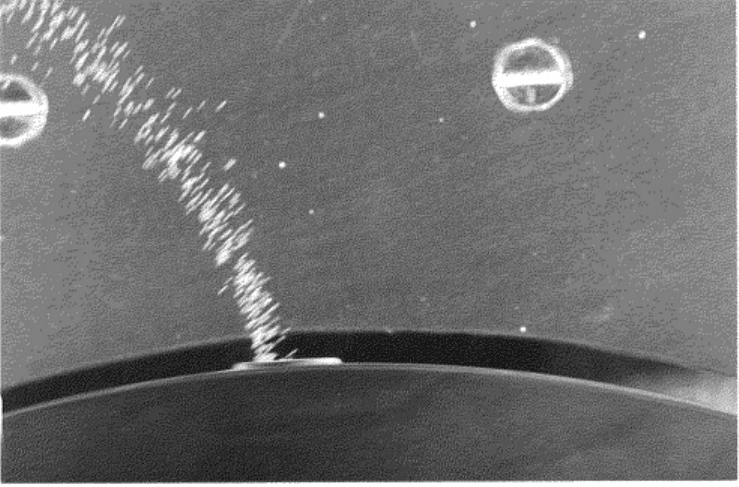
Fig. 8 Single flash exposure showing streak images of particle trajectories for olivine sand particles, 150–
250 μm in diameter, leaving an acceleration tube at the rim of the rotating disk in a centrifugal
accelerator of the design shown in Fig. 7. The disk was rotating clockwise and the mean particle velocity
was 7 m/s. Courtesy of T. Deng and M.S.A. Bradley, University of Greenwich, UK
Erosion at different impact angles can be achieved by varying the angles at which the specimens are mounted in
the apparatus. Because of the pattern of motion of the particles in this test, the impingement angle and the
particle flux vary in a complex but geometrically predictable way across the surface of a finite-sized specimen.
These effects have been analyzed in detail (Ref 15). At least one edge of the specimen will also, in general, be
exposed to the erodent stream, and it is common practice to mask both the leading and trailing edges of samples
in order to prevent erosion occurring at unwanted angles of impingement. The total amount of erodent striking
each specimen surface will be only a small fraction of the total fed into the rig and must be calculated from the
specimen and rig dimensions. The erosion of each specimen can then be calculated, in terms of mass removed
per unit mass of impinging erodent particles, from measurements of mass loss.
As in the gas-blast method discussed in the previous section, it is desirable to run the test to consume a
preweighed total mass of erodent, rather than rely on maintaining and measuring a steady particle feed rate and
running the test for a fixed time.
Wind-Tunnel Tests. Because of the large size and expense of the test rig, the wind-tunnel method shown
schematically in Fig. 4(c) is used predominantly where information on the performance of shaped components
such as turbine blades is required, rather than for studies of material response alone. For tests of the former
type, the wind tunnel method, in which the test specimen is immersed in a rapidly flowing stream of air or other
gas containing erodent particles, is invaluable. Figure 9 shows a typical wind tunnel test facility (Ref 17). The
specimen is located in a rectangular section (dimensions 25.4 × 76.2 mm, or 1 × 3 in.) of the wind tunnel,
following a long (approximately 4 m, or 13 ft) acceleration duct. With this length of acceleration tunnel,
relatively large particles (200 μm) are accelerated to up to 85% and smaller particles (20 μm) to up to 98% of
the air speed. In order to avoid disturbing the airflow too much, the specimen area in the test section is typically
restricted to <10% of the total cross-sectional area of the flow. After impact with the specimen, the erodent
particles, which have been supplied from a preweighed batch in the particle feeder, are separated from the main
airstream by a cyclone separator and filter.
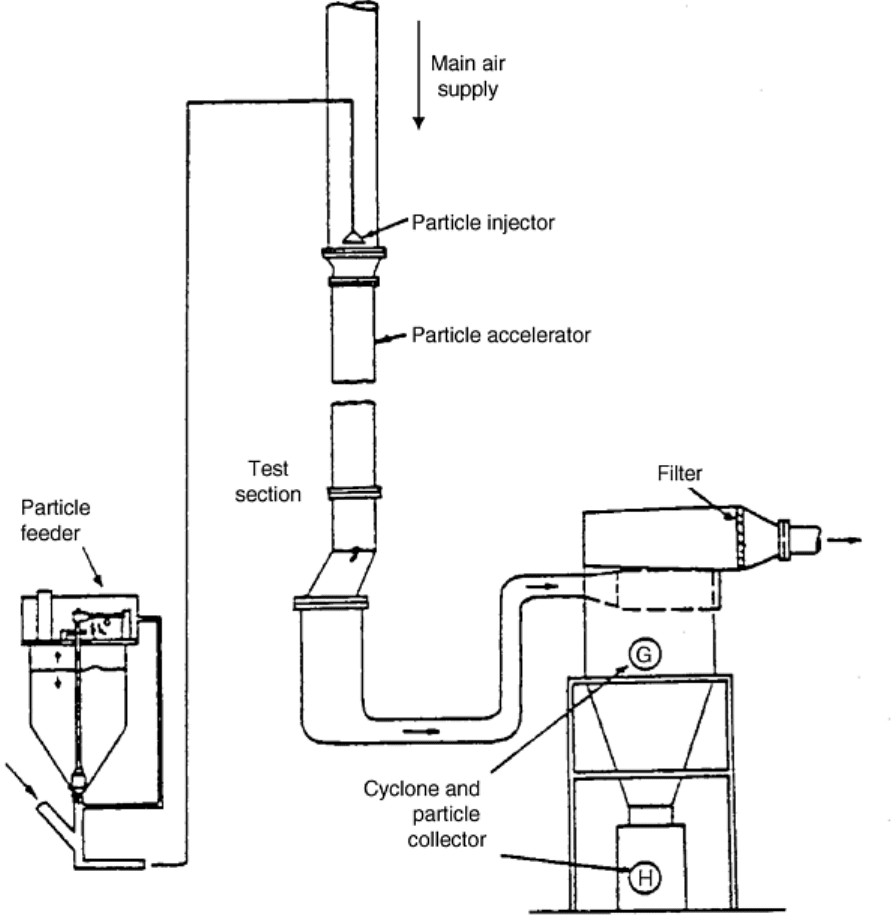
Fig. 9 Schematic diagram of wind tunnel test rig. Source: Ref 16
Whirling Arm Testers. Figure 10 shows an example of a whirling arm test rig in which impact occurs between a
moving specimen and a slowly falling stream of erodent particles. In this approach, which is particularly useful
in studying erosion at very high impact velocities, the specimens are carried at the ends of a rotating arm (Ref
14, 18). At high speeds, accurate balancing of both the arm and the specimens becomes important and
introduces extra complexity to the process of specimen preparation. Specimen materials must have sufficient
strength and ductility to withstand the high centrifugal stresses to which they are subjected during testing, and
satisfactory methods must be used to attach the specimens to the rotor. In some designs, aerodynamic effects
are eliminated by operating the rig in a vacuum or reduced air pressure, and this is essential if very high speeds
are required. There are then engineering problems associated with the sealing of the vacuum against the rapidly
rotating drive shaft, unless the method shown in Fig. 10 is adopted, where the motor casing itself provides the
vacuum seal.
